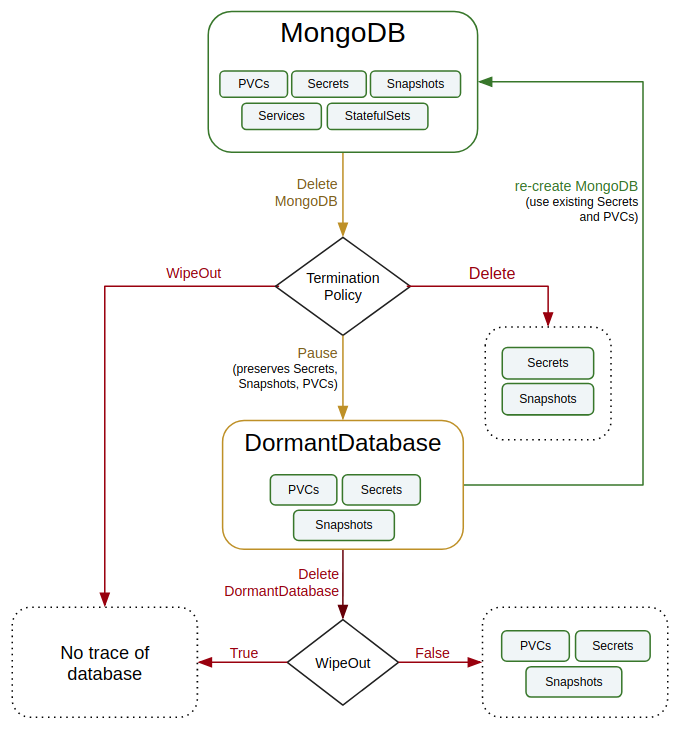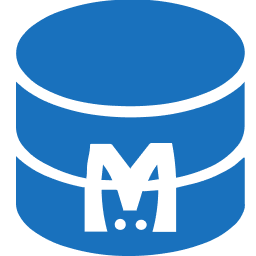You are looking at the documentation of a prior release. To read the documentation of the latest release, please
visit here.
New to KubeDB? Please start here.
MongoDB QuickStart
This tutorial will show you how to use KubeDB to run a MongoDB database.

Before You Begin
At first, you need to have a Kubernetes cluster, and the kubectl command-line tool must be configured to communicate with your cluster. If you do not already have a cluster, you can create one by using kind.
Now, install KubeDB cli on your workstation and KubeDB operator in your cluster following the steps here.
StorageClass is required to run KubeDB. Check the available StorageClass in cluster.
$ kubectl get storageclasses NAME PROVISIONER AGE standard (default) k8s.io/minikube-hostpath 4hTo keep things isolated, this tutorial uses a separate namespace called
demothroughout this tutorial. Run the following command to prepare your cluster for this tutorial:$ kubectl create ns demo namespace/demo created
Note: The yaml files used in this tutorial are stored in docs/examples/mongodb folder in GitHub repository kubedb/docs.
Find Available MongoDBVersion
When you have installed KubeDB, it has created MongoDBVersion crd for all supported MongoDB versions. Check 0
$ kubectl get mongodbversions
NAME VERSION DB_IMAGE DEPRECATED AGE
3.4 3.4 maruftuhin/mongo:3.4 true 5h41m
3.4-v1 3.4 maruftuhin/mongo:3.4-v1 true 5h41m
3.4-v2 3.4 maruftuhin/mongo:3.4-v2 true 5h41m
3.4-v3 3.4 maruftuhin/mongo:3.4-v3 5h41m
3.6 3.6 maruftuhin/mongo:3.6 true 5h41m
3.6-v1 3.6 maruftuhin/mongo:3.6-v1 true 5h41m
3.6-v2 3.6 maruftuhin/mongo:3.6-v2 true 5h41m
3.6-v3 3.6 maruftuhin/mongo:3.6-v3 5h41m
4.0 4.0.5 maruftuhin/mongo:4.0 true 5h41m
4.0-v1 4.0.5 maruftuhin/mongo:4.0-v1 5h41m
4.0.5 4.0.5 maruftuhin/mongo:4.0.5 true 5h41m
4.0.5-v1 4.0.5 maruftuhin/mongo:4.0.5-v1 5h41m
4.1.7 4.1.7 maruftuhin/mongo:4.1.7 true 5h41m
4.1.7-v1 4.1.7 maruftuhin/mongo:4.1.7-v1 5h41m
Create a MongoDB database
KubeDB implements a MongoDB CRD to define the specification of a MongoDB database. Below is the MongoDB object created in this tutorial.
apiVersion: kubedb.com/v1alpha2
kind: MongoDB
metadata:
name: mgo-quickstart
namespace: demo
spec:
version: "3.4-v3"
storageType: Durable
storage:
storageClassName: "standard"
accessModes:
- ReadWriteOnce
resources:
requests:
storage: 1Gi
terminationPolicy: DoNotTerminate
$ kubectl create -f https://github.com/kubedb/docs/raw/v2021.01.15/docs/examples/mongodb/quickstart/demo-1.yaml
mongodb.kubedb.com/mgo-quickstart created
Here,
spec.versionis name of the MongoDBVersion crd where the docker images are specified. In this tutorial, a MongoDB 3.4-v3 database is created.spec.storageTypespecifies the type of storage that will be used for MongoDB database. It can beDurableorEphemeral. Default value of this field isDurable. IfEphemeralis used then KubeDB will create MongoDB database usingEmptyDirvolume. In this case, you don’t have to specifyspec.storagefield. This is useful for testing purposes.spec.storagespecifies PVC spec that will be dynamically allocated to store data for this database. This storage spec will be passed to the StatefulSet created by KubeDB operator to run database pods. You can specify any StorageClass available in your cluster with appropriate resource requests.spec.terminationPolicygives flexibility whether tonullify(reject) the delete operation ofMongoDBcrd or which resources KubeDB should keep or delete when you deleteMongoDBcrd. If admission webhook is enabled, It prevents users from deleting the database as long as thespec.terminationPolicyis set toDoNotTerminate. Learn details of allTerminationPolicy[here]
Note: spec.storage section is used to create PVC for database pod. It will create PVC with storage size specified instorage.resources.requests field. Don’t specify limits here. PVC does not get resized automatically.
KubeDB operator watches for MongoDB objects using Kubernetes api. When a MongoDB object is created, KubeDB operator will create a new StatefulSet and a Service with the matching MongoDB object name. KubeDB operator will also create a governing service for StatefulSets with the name <mongodb-name>-gvr.
$ kubectl dba describe mg -n demo mgo-quickstart
Name: mgo-quickstart
Namespace: demo
CreationTimestamp: Wed, 06 Feb 2019 11:25:26 +0600
Labels: <none>
Annotations: <none>
Replicas: 1 total
Status: Running
StorageType: Durable
Volume:
StorageClass: standard
Capacity: 1Gi
Access Modes: RWO
StatefulSet:
Name: mgo-quickstart
CreationTimestamp: Wed, 06 Feb 2019 11:25:27 +0600
Labels: app.kubernetes.io/name=mongodbs.kubedb.com
app.kubernetes.io/instance=mgo-quickstart
Annotations: <none>
Replicas: 824637515568 desired | 1 total
Pods Status: 1 Running / 0 Waiting / 0 Succeeded / 0 Failed
Service:
Name: mgo-quickstart
Labels: app.kubernetes.io/name=mongodbs.kubedb.com
app.kubernetes.io/instance=mgo-quickstart
Annotations: <none>
Type: ClusterIP
IP: 10.111.237.184
Port: db 27017/TCP
TargetPort: db/TCP
Endpoints: 172.17.0.8:27017
Service:
Name: mgo-quickstart-gvr
Labels: app.kubernetes.io/name=mongodbs.kubedb.com
app.kubernetes.io/instance=mgo-quickstart
Annotations: service.alpha.kubernetes.io/tolerate-unready-endpoints=true
Type: ClusterIP
IP: None
Port: db 27017/TCP
TargetPort: 27017/TCP
Endpoints: 172.17.0.8:27017
Database Secret:
Name: mgo-quickstart-auth
Labels: app.kubernetes.io/name=mongodbs.kubedb.com
app.kubernetes.io/instance=mgo-quickstart
Annotations: <none>
Type: Opaque
Data
====
password: 16 bytes
username: 4 bytes
No Snapshots.
Events:
Type Reason Age From Message
---- ------ ---- ---- -------
Normal Successful 8m MongoDB operator Successfully created Service
Normal Successful 8m MongoDB operator Successfully created StatefulSet
Normal Successful 8m MongoDB operator Successfully created MongoDB
Normal Successful 8m MongoDB operator Successfully created appbinding
Normal Successful 8m MongoDB operator Successfully patched StatefulSet
Normal Successful 8m MongoDB operator Successfully patched MongoDB
$ kubectl get statefulset -n demo
NAME DESIRED CURRENT AGE
mgo-quickstart 1 1 20m
$ kubectl get pvc -n demo
NAME STATUS VOLUME CAPACITY ACCESS MODES STORAGECLASS AGE
datadir-mgo-quickstart-0 Bound pvc-9c738632-29cf-11e9-aebf-080027875192 1Gi RWO standard 16m
$ kubectl get pv -n demo
NAME CAPACITY ACCESS MODES RECLAIM POLICY STATUS CLAIM STORAGECLASS REASON AGE
pvc-9c738632-29cf-11e9-aebf-080027875192 1Gi RWO Delete Bound demo/datadir-mgo-quickstart-0 standard 17m
$ kubectl get service -n demo
NAME TYPE CLUSTER-IP EXTERNAL-IP PORT(S) AGE
mgo-quickstart ClusterIP 10.111.237.184 <none> 27017/TCP 18m
mgo-quickstart-gvr ClusterIP None <none> 27017/TCP 18m
KubeDB operator sets the status.phase to Running once the database is successfully created. Run the following command to see the modified MongoDB object:
$ kubectl get mg -n demo mgo-quickstart -o yaml
apiVersion: kubedb.com/v1alpha2
kind: MongoDB
metadata:
creationTimestamp: "2019-04-30T09:55:13Z"
finalizers:
- kubedb.com
generation: 2
name: mgo-quickstart
namespace: demo
resourceVersion: "31337"
selfLink: /apis/kubedb.com/v1alpha2/namespaces/demo/mongodbs/mgo-quickstart
uid: 0c5c22d6-6b2e-11e9-97a6-0800278b6754
spec:
authSecret:
name: mgo-quickstart-auth
podTemplate:
controller: {}
metadata: {}
spec:
livenessProbe:
exec:
command:
- mongo
- --eval
- db.adminCommand('ping')
failureThreshold: 3
periodSeconds: 10
successThreshold: 1
timeoutSeconds: 5
readinessProbe:
exec:
command:
- mongo
- --eval
- db.adminCommand('ping')
failureThreshold: 3
periodSeconds: 10
successThreshold: 1
timeoutSeconds: 1
resources: {}
securityContext:
fsGroup: 999
runAsNonRoot: true
runAsUser: 999
replicas: 1
serviceTemplate:
metadata: {}
spec: {}
storage:
accessModes:
- ReadWriteOnce
dataSource: null
resources:
requests:
storage: 1Gi
storageClassName: standard
storageType: Durable
terminationPolicy: DoNotTerminate
version: 3.4-v3
status:
observedGeneration: 2$4213139756412538772
phase: Running
Please note that KubeDB operator has created a new Secret called mgo-quickstart-auth (format: {mongodb-object-name}-auth) for storing the password for mongodb superuser. This secret contains a username key which contains the username for MongoDB superuser and a password key which contains the password for MongoDB superuser.
If you want to use custom or existing secret please specify that when creating the MongoDB object using spec.authSecret.name. While creating this secret manually, make sure the secret contains these two keys containing data user and password. For more details, please see here.
Now, you can connect to this database through mongo-shell. In this tutorial, we are connecting to the MongoDB server from inside the pod.
$ kubectl get secrets -n demo mgo-quickstart-auth -o jsonpath='{.data.\username}' | base64 -d
root
$ kubectl get secrets -n demo mgo-quickstart-auth -o jsonpath='{.data.\password}' | base64 -d
t1QJppJw_B13UIES
$ kubectl exec -it mgo-quickstart-0 -n demo sh
> mongo admin
> db.auth("root","t1QJppJw_B13UIES")
1
> show dbs
admin 0.000GB
local 0.000GB
mydb 0.000GB
> show users
{
"_id" : "admin.root",
"user" : "root",
"db" : "admin",
"roles" : [
{
"role" : "root",
"db" : "admin"
}
]
}
> use newdb
switched to db newdb
> db.movie.insert({"name":"batman"});
WriteResult({ "nInserted" : 1 })
> db.movie.find().pretty()
{ "_id" : ObjectId("5a2e435d7ec14e7bda785f16"), "name" : "batman" }
> exit
bye
DoNotTerminate Property
When terminationPolicy is DoNotTerminate, KubeDB takes advantage of ValidationWebhook feature in Kubernetes 1.9.0 or later clusters to implement DoNotTerminate feature. If admission webhook is enabled, It prevents users from deleting the database as long as the spec.terminationPolicy is set to DoNotTerminate. You can see this below:
$ kubectl delete mg mgo-quickstart -n demo
Error from server (BadRequest): admission webhook "mongodb.validators.kubedb.com" denied the request: mongodb "mgo-quickstart" can't be halted. To delete, change spec.terminationPolicy
Now, run kubectl edit mg mgo-quickstart -n demo to set spec.terminationPolicy to Halt (which creates dormantdatabase when mongodb is deleted and keeps PVC, snapshots, Secrets intact) or remove this field (which default to Halt). Then you will be able to delete/halt the database.
Learn details of all TerminationPolicy here.
Halt Database
When TerminationPolicy is set to Halt, it will halt the MongoDB database instead of deleting it. Here, If you delete the MongoDB object, KubeDB operator will delete the StatefulSet and its pods but leaves the PVCs unchanged. In KubeDB parlance, we say that mgo-quickstart MongoDB database has entered into the dormant state. This is represented by KubeDB operator by creating a matching DormantDatabase object.
$ kubectl delete mg mgo-quickstart -n demo
mongodb.kubedb.com "mgo-quickstart" deleted
$ kubectl get drmn -n demo mgo-quickstart
NAME STATUS AGE
mgo-quickstart Pausing 39s
$ kubectl get drmn -n demo mgo-quickstart
NAME STATUS AGE
mgo-quickstart Halted 21s
$ kubectl get drmn -n demo mgo-quickstart -o yaml
apiVersion: kubedb.com/v1alpha2
kind: DormantDatabase
metadata:
creationTimestamp: "2019-04-30T09:57:34Z"
finalizers:
- kubedb.com
generation: 1
labels:
app.kubernetes.io/name: mongodbs.kubedb.com
name: mgo-quickstart
namespace: demo
resourceVersion: "31482"
selfLink: /apis/kubedb.com/v1alpha2/namespaces/demo/dormantdatabases/mgo-quickstart
uid: 60d472f1-6b2e-11e9-97a6-0800278b6754
spec:
origin:
metadata:
creationTimestamp: "2019-04-30T09:55:13Z"
name: mgo-quickstart
namespace: demo
spec:
mongodb:
authSecret:
name: mgo-quickstart-auth
podTemplate:
controller: {}
metadata: {}
spec:
livenessProbe:
exec:
command:
- mongo
- --eval
- db.adminCommand('ping')
failureThreshold: 3
periodSeconds: 10
successThreshold: 1
timeoutSeconds: 5
readinessProbe:
exec:
command:
- mongo
- --eval
- db.adminCommand('ping')
failureThreshold: 3
periodSeconds: 10
successThreshold: 1
timeoutSeconds: 1
resources: {}
securityContext:
fsGroup: 999
runAsNonRoot: true
runAsUser: 999
replicas: 1
serviceTemplate:
metadata: {}
spec: {}
storage:
accessModes:
- ReadWriteOnce
dataSource: null
resources:
requests:
storage: 1Gi
storageClassName: standard
storageType: Durable
terminationPolicy: Halt
version: 3.4-v3
status:
observedGeneration: 1$16440556888999634490
pausingTime: "2019-04-30T09:57:44Z"
phase: Halted
Here,
spec.originis the spec of the original spec of the original MongoDB object.status.phasepoints to the current database stateHalted.
Resume Dormant Database
To resume the database from the dormant state, create same MongoDB object with same Spec.
In this tutorial, the dormant database can be resumed by creating original MongoDB object.
The below command will resume the DormantDatabase mgo-quickstart.
$ kubectl create -f https://github.com/kubedb/docs/raw/v2021.01.15/docs/examples/mongodb/quickstart/demo-1.yaml
mongodb.kubedb.com/mgo-quickstart created
Now, if you exec into the database, you can see that the datas are intact.
WipeOut DormantDatabase
You can wipe out a DormantDatabase while deleting the object by setting spec.wipeOut to true. KubeDB operator will delete any relevant resources of this MongoDB database (i.e, PVCs, Secrets, Snapshots). It will also delete snapshot data stored in the Cloud Storage buckets.
$ kubectl edit drmn -n demo mgo-quickstart
apiVersion: kubedb.com/v1alpha2
kind: DormantDatabase
metadata:
name: mgo-quickstart
namespace: demo
...
spec:
wipeOut: true
...
status:
phase: Halted
...
If spec.wipeOut is not set to true while deleting the dormantdatabase object, then only this object will be deleted and kubedb-operator won’t delete related Secrets, PVCs, and Snapshots. So, users still can access the stored data in the cloud storage buckets as well as PVCs.
Delete DormantDatabase
As it is already discussed above, DormantDatabase can be deleted with or without wiping out the resources. To delete the dormantdatabase,
$ kubectl delete drmn mgo-quickstart -n demo
dormantdatabase "mgo-quickstart" deleted
Cleaning up
To cleanup the Kubernetes resources created by this tutorial, run:
kubectl patch -n demo mg/mgo-quickstart -p '{"spec":{"terminationPolicy":"WipeOut"}}' --type="merge"
kubectl delete -n demo mg/mgo-quickstart
kubectl patch -n demo drmn/mgo-quickstart -p '{"spec":{"wipeOut":true}}' --type="merge"
kubectl delete -n demo drmn/mgo-quickstart
kubectl delete ns demo
Tips for Testing
If you are just testing some basic functionalities, you might want to avoid additional hassles due to some safety features that are great for production environment. You can follow these tips to avoid them.
- Use
storageType: Ephemeral. Databases are precious. You might not want to lose your data in your production environment if database pod fail. So, we recommend to usespec.storageType: Durableand provide storage spec inspec.storagesection. For testing purpose, you can just usespec.storageType: Ephemeral. KubeDB will use emptyDir for storage. You will not require to providespec.storagesection. - Use
terminationPolicy: WipeOut. It is nice to be able to resume database from previous one. So, we createDormantDatabaseand preserve all yourPVCs,Secrets,Snapshotsetc. If you don’t want to resume database, you can just usespec.terminationPolicy: WipeOut. It will not createDormantDatabaseand it will delete everything created by KubeDB for a particular MongoDB crd when you delete the crd. For more details about termination policy, please visit here.
Next Steps
- Backup and Restore MongoDB databases using Stash.
- Initialize MongoDB with Script.
- Monitor your MongoDB database with KubeDB using out-of-the-box Prometheus operator.
- Monitor your MongoDB database with KubeDB using out-of-the-box builtin-Prometheus.
- Use private Docker registry to deploy MongoDB with KubeDB.
- Detail concepts of MongoDB object.
- Detail concepts of MongoDBVersion object.
- Want to hack on KubeDB? Check our contribution guidelines.



































